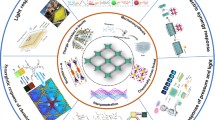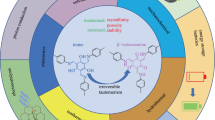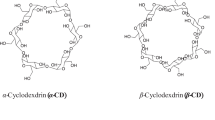Abstract
A novel method to recognize cis/trans isomers was studied here. The naphthalimide dye as guest could bind with host cucurbit [7]uril (CB [7]) and 1:1 naphthalimide dye ⊂ CB [7] assembly was formed. Moreover, this assembly was used as a fluorescent probe to recognized Fumaric acid (FA) and maleic acid (MA) via fluorescence titration. Two carboxyls in MA are in the same side, they could form stable interaction with the assembly and the fluorescence intensity decreased obviously when naphthalimide dye ⊂ CB [7] was titrated by MA (nearly quenched in 1.5 equiv). But two carboxyls in FA are in opposite sides, the interaction between FA and the assembly was weak and not stable, and the fluorescence intensity changed inconspicuously when the assembly was titrated by FA.







Similar content being viewed by others
References
Hasdenteufel F (2006) Twenty years of separation of cis-trans (Z)-(E) isomers. Sep Purif Rev 35:193–221
Yuan XY, Zhang M, Ng SW (2009) Perillartine. Acta Crystallo graphica Section E 65:o2149
Wilson ME, Mook D, Graves F, Felger J, Bielsky IF, Wallen K (2003) Tamoxifen is an estrogen Antagonist on Gonadotropin Secretion and Responsiveness of the Hypothalamic–Pituitary–Adrenal Axis in Female Monkeys. Endocrine 22:305–315
Yadav M, Dixit P, Trivedi V, et al. (2009) Chromatographic separation of (E)- and (Z)-isomers of entacapone and their simultaneous quantitation in human plasma by LC-ESIMS/MS. J Chromatogr B 877:533–540
Li YW, Fang HW, Liang SX, Wang ZZ (2008) Simultaneous determination of cis- and trans-boutendioic acid by partial least squares-ultraviolet spectrophotometry. Chinese Journal of Analytical Chemistry. 36:95–98
Dsouza RN, Pischel U, Nau WM (2011) Fluorescent dyes and their supramolecular host/guest complexes with macrocycles in aqueous solution. Chem Rev 111:7941–7980
Mandadapu V, Day AI, Ghanem A (2014) Cucurbituril: Chiral applications. Chirality 26:712–723
Behrend R, Meyer E, Rusche F (1905) Condensation products from glycoluril and formaldehyde. Liebigs Ann Chem 339:1–37
Freeman WA, Mock WL, Shih NY (1981) Cucurbituril. J Am Chem Soc 103:7367–7368
Kim J, Jung IS, Kim SY, Lee E, Kang JK, Sakamoto S, Yamaguchi K, Kim K (2000) New cucurbituril homologues: Syntheses, Isolation, characterization, and X-ray Crystal Structures of cucurbit[n]uril (n = 5, 7, and 8). J Am Chem Soc 122:540–541
Day AI, Blanch RJ, Arnold AP, Lorenzo S, Lewis GR, Dance I (2002) A cucurbituril-based gyroscane: A new supramolecular form. Angew Chem Int Ed 41:275–277
Lee JW, Samal S, Selvapalam N, Kim HJ, Kim K (2003) Cucurbituril homologues and Derivatives: new Opportunities in supramolecular chemistry. Acc Chem Res 36:621–630
Florea M, Nau WM (2011) Strong binding of hydrocarbons to cucurbituril Probed by fluorescent dye Displacement: A supramolecular Gas-Sensing Ensemble. Angew Chem Int Ed 50:9338–9342
Li ZY, Sun SG, Y Liu F, Pang Y, JL F, FL S, XJ P (2012) Large fluorescence enhancement of a hemicyanine by supramolecular interaction with cucurbit[6]uril and its application as resettable logic gates. Dyes Pigments 93:1401–1407
Buschmann HJ, Scholimeyer E (1997) Cucurbituril and -Cyclodextrin as Hosts for the Complexation of Organic dyes. J Incl Phenom Mol Recognit Chem 29:167–174
Kemp S, Wheate NJ, Stootman FH, Aldrich-Wright JR (2007) The host-guest chemistry of Proflavine with cucurbit[6,7,8]urils. Supramol Chem 19:475–484
Chernikova EY, Berdnikova DV, Fedorov YV, Fedorova OA (2013) Effective Stabilization of cis-Isomer of styryl dye inside the cucurbit[7]uril cavity. Macroheterocycles 6:234–239
Karcher S, Kornmuller A, Jekel M (2001) Cucurbituril for Water Treatment. Part I: Solubility of cucurbituril and Reactive dyes. Water Res 35:3309–3316
Jiao DZ, Scherman OA (2012) Isolation of cucurbit[n]uril homologues with imidazolium salts in a recyclable manner. Green Chem 14:2445–2449
Elbert JE, Paulsen S, Robinson L, Elzey S, Klein K (2005) A study of 4-(alkylamino)amino substituted 1,8-naphthalimide fluoroionophores. J Photochem Photobiol A Chem 169:9–19
Acknowledgment
This work is supported by the National Natural Science Foundation of China (Grant NO. 21406108).
Author information
Authors and Affiliations
Corresponding authors
Rights and permissions
About this article
Cite this article
Li, J., Gu, X., Yuan, X. et al. Cis/trans Fluorescent Recognition by Naphthalimide Dyes ⊂ CB [7] Assembly. J Fluoresc 26, 1219–1224 (2016). https://doi.org/10.1007/s10895-016-1807-2
Received:
Accepted:
Published:
Issue Date:
DOI: https://doi.org/10.1007/s10895-016-1807-2




